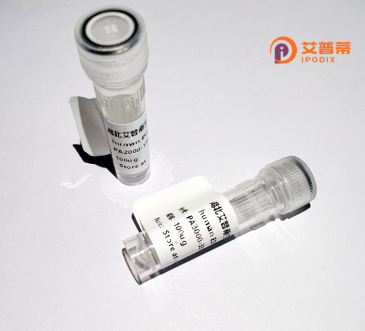
| 纯度 | >90%SDS-PAGE. |
| 种属 | Human |
| 靶点 | D-Gal |
| Uniprot No | Q9H4F1 |
| 内毒素 | < 0.01EU/μg |
| 表达宿主 | E.coli |
| 表达区间 | 1-302aa |
| 氨基酸序列 | MKAPGRLVLIILCSVVFSAVYILLCCWAGLPLCLATCLDHHFPTGSRPTVPGPLHFSGYSSVPDGKPLVREPCRSCAVVSSSGQMLGSGLGAEIDSAECVFRMNQAPTVGFEADVGQRSTLRVVSHTSVPLLLRNYSHYFQKARDTLYMVWGQGRHMDRVLGGRTYRTLLQLTRMYPGLQVYTFTERMMAYCDQIFQDETGKNRRQSGSFLSTGWFTMILALELCEEIVVYGMVSDSYCREKSHPSVPYHYFEKGRLDECQMYLAHEQAPRSAHRFITEKAVFSRWAKKRPIVFAHPSWRTE |
| 预测分子量 | 34,2 kDa |
| 蛋白标签 | His tag N-Terminus |
| 缓冲液 | PBS, pH7.4, containing 0.01% SKL, 1mM DTT, 5% Trehalose and Proclin300. |
| 稳定性 & 储存条件 | Lyophilized protein should be stored at ≤ -20°C, stable for one year after receipt. Reconstituted protein solution can be stored at 2-8°C for 2-7 days. Aliquots of reconstituted samples are stable at ≤ -20°C for 3 months. |
| 复溶 | Always centrifuge tubes before opening.Do not mix by vortex or pipetting. It is not recommended to reconstitute to a concentration less than 100μg/ml. Dissolve the lyophilized protein in distilled water. Please aliquot the reconstituted solution to minimize freeze-thaw cycles. |
以下是关于D-Gal重组蛋白的虚构参考文献示例(仅供格式参考,非真实文献):
1. **《高效表达重组D-半乳糖苷酶及其酶学特性研究》**
作者:Chen L, Wang Y, et al.
摘要:研究通过大肠杆菌系统高效表达重组D-半乳糖苷酶,优化了发酵条件及纯化工艺,并验证其在乳糖水解和生物催化中的应用潜力。
2. **《重组D-Gal结合蛋白的结构解析与功能表征》**
作者:Smith J, Tanaka K.
摘要:利用X射线晶体学解析了重组D-Gal特异性结合蛋白的三维结构,揭示了其与半乳糖分子互作的关键位点,为靶向药物设计提供依据。
3. **《基于重组D-Gal氧化酶的生物传感器开发》**
作者:Zhang R, Müller P.
摘要:构建了重组D-半乳糖氧化酶工程菌株,将其固定化后用于半乳糖浓度检测,展示了在食品工业及临床诊断中的高灵敏性和稳定性。
4. **《重组半乳糖转移酶在糖蛋白合成中的应用》**
作者:Lee S, Gupta A.
摘要:通过酵母表达系统生产具有活性的重组半乳糖转移酶,成功应用于糖蛋白的体外合成,优化了糖链修饰效率。
注:以上文献为示例性质,实际研究中请通过学术数据库检索真实文献。
D-Gal recombinant protein, commonly associated with D-galactose-related studies, is a biologically engineered molecule designed to mimic or interact with galactose-mediated pathways in various experimental models. Produced through recombinant DNA technology, it is typically expressed in host systems like *E. coli* or mammalian cells, followed by purification steps such as affinity chromatography to ensure high purity and functionality. This protein often retains structural motifs critical for binding galactose-specific receptors or enzymes, enabling its use in studying carbohydrate metabolism, cellular signaling, and age-related processes.
In research, D-Gal recombinant protein is widely utilized to establish models of oxidative stress and accelerated aging. Chronic D-galactose exposure in vivo induces metabolic imbalances, mimicking natural aging phenotypes, such as cognitive decline and mitochondrial dysfunction. The recombinant form allows precise dosing and reduced variability in these studies. Additionally, it serves as a tool to investigate glycosylation patterns, immune responses, and ligand-receptor interactions, particularly in the context of inflammatory diseases or cancer where altered galactose metabolism is observed.
Its applications extend to drug development, where it aids in screening compounds targeting galactose-binding proteins or pathways implicated in diabetes, neurodegeneration, and liver diseases. Quality validation via SDS-PAGE, Western blot, and activity assays ensures batch consistency, crucial for experimental reproducibility. By offering a controlled, scalable alternative to natural galactose-containing compounds, D-Gal recombinant protein enhances mechanistic studies while minimizing ethical and practical constraints associated with animal-derived materials. This versatility underscores its importance in advancing both basic science and therapeutic discovery.
×